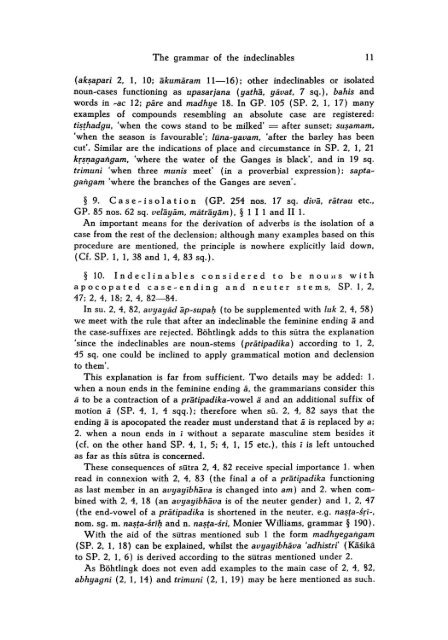Studies on Panini's grammar - DWC
Studies on Panini's grammar - DWC
Studies on Panini's grammar - DWC
You also want an ePaper? Increase the reach of your titles
YUMPU automatically turns print PDFs into web optimized ePapers that Google loves.
The <strong>grammar</strong> of the indeclinables 11<br />
(ak~apari 2, 1. 10; akumäram 11-16); other indeclinables or isolated<br />
noun~cases functi<strong>on</strong>ing as upasarjana (yatha, yävat, 7 sq. ), bahis and<br />
words in ~ac 12; päre and madhye 18. In GP. 105 (SP. 2, I, 17) many<br />
examples of compounds resembling an absolute case are registered:<br />
ti~thadgu, 'when the cows stand to be milked' = af ter sunset; su~amam ,<br />
'when the seas<strong>on</strong> is favourable'; lüna~yavam , 'af ter the barley has been<br />
cut'. Similar are the indicati<strong>on</strong>s of place and circumstance in SP. 2, I, 21<br />
kr~1JagaTigam, 'wh ere the water of the Ganges is black', and in 19 sq.<br />
trimuni 'when three munis meet' (in a proverbial expressi<strong>on</strong> ) ; sapta~<br />
gangam 'wh ere the branches of the Ganges are seven'.<br />
§ 9. Case~isolati<strong>on</strong> (GP. 254 nos. 17 sq. diva, rätrau etc.,<br />
GP. 85 nos. 62 sq. velayäm, mätrayam). § 1 I 1 and 11 1.<br />
An important means for the derivati<strong>on</strong> of adverbs is the isolati<strong>on</strong> of a<br />
case from the rest of the declensi<strong>on</strong>; although many examples based <strong>on</strong> th is<br />
procedure are menti<strong>on</strong>ed, the principle is nowhere explicitly laid down,<br />
(Cf. SP. I , 1. 38 and 1, 4,83 sq.).<br />
§ 10. In dec I i n a bIe 5 c<strong>on</strong> 5 i der e d tob e nou i! 5 wit h<br />
apo c 0 pat ede ase ~ end i n 9 a n d ne u ter 5 tem 5 , SP. 1. 2,<br />
47; 2, 4, 18; 2,4, 82- 84.<br />
In su. 2, 4, 82, avyayäd ap-supalJ (to be supplemented with luk 2, 4, 58)<br />
we meet with the rule that af ter an indeclinable the feminine ending a and<br />
the case ~ suffixes are rejected. Böhtlingk adds to this sütra the explanati<strong>on</strong><br />
'since the indeclinables are noun-stems (prätipadika) according to I, 2,<br />
45 sq. <strong>on</strong>e could be inclined to apply grammatical moti<strong>on</strong> and declensi<strong>on</strong><br />
to them'.<br />
This explanati<strong>on</strong> is far from sufficient. Two details may be added: 1.<br />
when a noun ends in the feminine en ding ä, the <strong>grammar</strong>ians c<strong>on</strong>sider this<br />
ä to be a c<strong>on</strong>tract i<strong>on</strong> of a pratipadika~vowel a and an additi<strong>on</strong>al suffix of<br />
mot i<strong>on</strong> ä (SP. 4, 1. 4 sqq.); therefore when sÜ. 2, 4, 82 says th at the<br />
ending a is apocopated the reader must understand that ä is replaced by a ;<br />
2. when a noun ends in i without a separate masculine stem besides it<br />
(cf. <strong>on</strong> the other hand SP. 4, I, 5; 4, I , 15 etc.), this i is left untouched<br />
as far as this sütra is c<strong>on</strong>cerned.<br />
These c<strong>on</strong>sequences of sutra 2, 4, 82 receive special importance 1. when<br />
read in c<strong>on</strong>nexi<strong>on</strong> with 2, 4, 83 (the final a of a pratipadika functi<strong>on</strong>ing<br />
as last member in an avyayibhava is changed into am) and 2. wh en com~<br />
bined with 2, 4, 18 (an avyayibhava is of the neuter gender) and I , 2, 47<br />
(the end-vowel of a prätipadika is shortened in the neuter, e.g. n~ta -sri - ,<br />
nom. sg. m. na~ta~srïQ and n. na~ta~sri, M<strong>on</strong>ier W illiams, <strong>grammar</strong> § 190).<br />
With the aid of the sütras menti<strong>on</strong>ed sub 1 the form madhyegangam<br />
(SP. 2. I , 18) can be explained, whilst the avyayibhäva 'adhistri' (Käsikä<br />
to SP. 2, I , 6) is derived according to the sutl'as menti<strong>on</strong>ed under 2.<br />
As Böhtlingk does not even add examples to the main case of 2, 4, S2,<br />
abhyagni (2, I , 14) and trimuni (2, I , 19) may be here menti<strong>on</strong>ed as sUl:h.
















